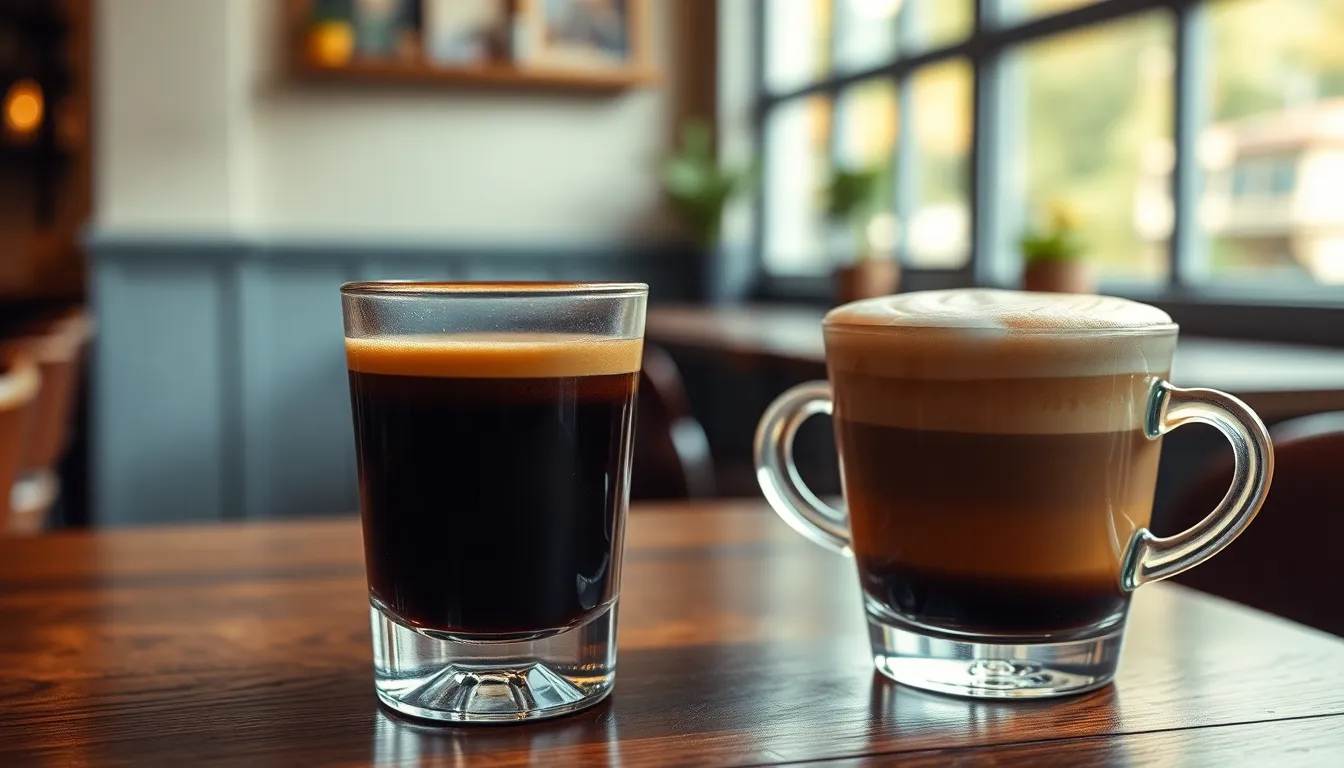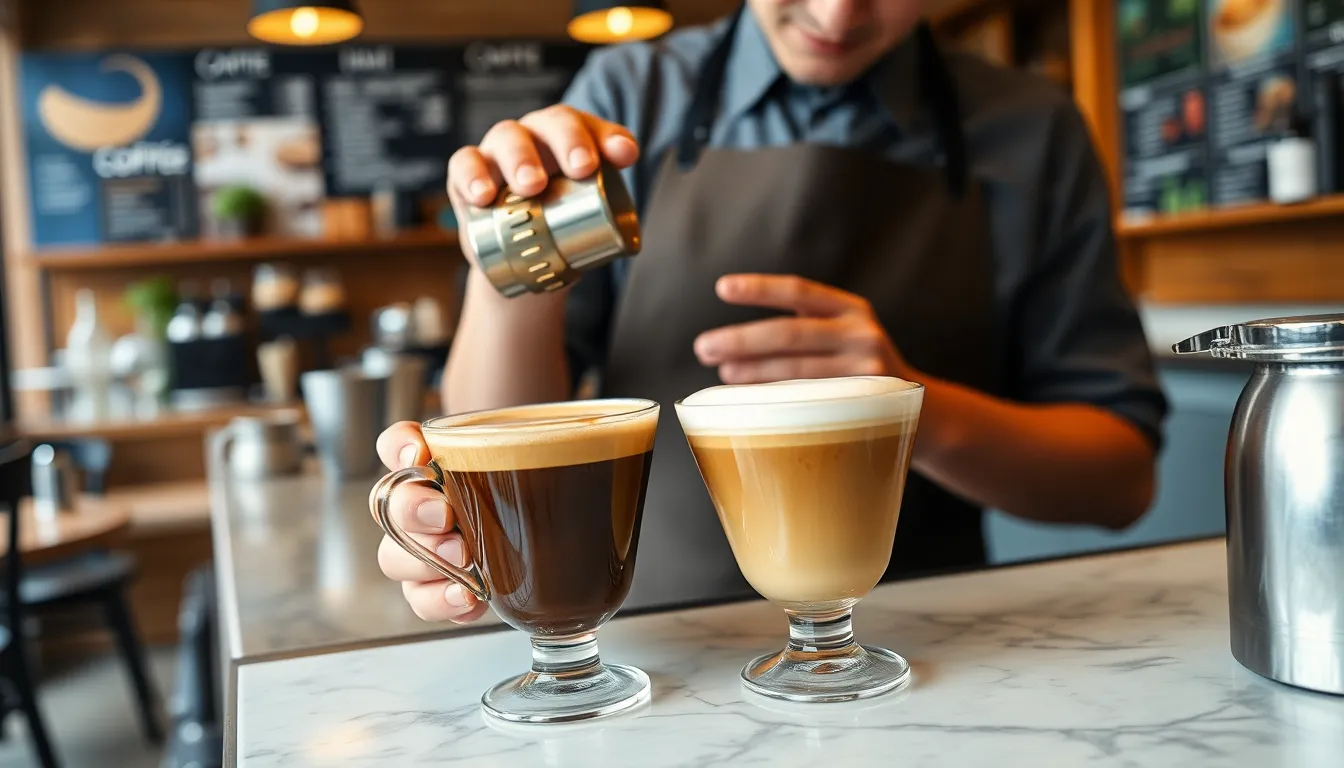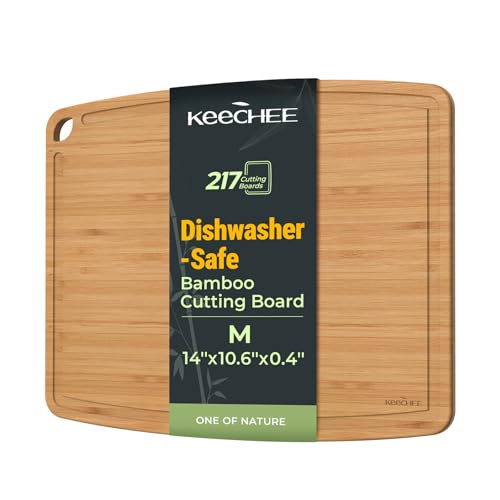Curious about the difference between a cortado vs cappuccino when scanning the coffee shop menu? These two espresso-based drinks might seem similar at first peek, but they offer distinctly different experiences for your taste buds.
While both beverages feature espresso and steamed milk, the ratio, texture, and serving style set them apart. A cortado delivers a balanced, seamless process with equal parts espresso and lightly steamed milk, while a cappuccino creates a more layered sensation with its equal thirds of espresso, steamed milk, and milk foam. Whether you’re looking for a stronger coffee flavor or a creamier, more textured drink, understanding these differences will help you order your perfect cup.
What Is a Cortado?
A cortado is an espresso-based coffee beverage that perfectly balances equal parts espresso and lightly steamed milk. This small but mighty drink offers coffee enthusiasts a harmonious taste experience where the milk softens the acidity of the espresso without masking its rich flavor profile.
Origin and History
The cortado originated in Spain’s Basque country, with its name deriving from the Spanish word “cortar,” meaning “to cut.” Spanish coffee culture embraced this drink as a mid-morning staple, appreciating how the milk “cuts” through the intensity of the espresso. During the early 20th century, the cortado spread throughout Spain and eventually to Portugal, where it gained popularity as “pingado.” The drink made its way to Latin American countries like Cuba and Argentina, each adding subtle regional variations. By the early 2000s, specialty coffee shops across the United States began featuring cortados on their menus, introducing many Americans to this balanced espresso beverage for the first time.
Traditional Preparation Method
The traditional cortado preparation involves pulling a double shot (2 oz) of espresso using freshly ground coffee beans. Baristas then steam an equal amount (2 oz) of whole milk to approximately 130°F, creating minimal microfoam compared to other coffee drinks. The warm milk gets carefully poured into the espresso, resulting in a 4 oz beverage with a thin layer of microfoam on top. Unlike cappuccinos, cortados aren’t typically served with art or decorative elements on the surface. Glass tumblers or small ceramic cups traditionally hold this drink, allowing coffee lovers to appreciate its caramel-colored layers. The lower temperature of a cortado makes it immediately drinkable without waiting for it to cool.
What Is a Cappuccino?

A cappuccino stands as one of the most beloved coffee beverages worldwide, characterized by its perfect balance of espresso, steamed milk, and foam. This iconic Italian drink offers a harmonious blend of flavors that coffee enthusiasts have cherished for generations.
Italian Heritage
Italy’s rich coffee culture gave birth to the cappuccino, which derives its name from the Capuchin friars whose brown robes resembled the color of the drink. The cappuccino emerged in the early 20th century but gained international popularity after Industry War II. Traditionally served in a 6 oz ceramic cup, modern variations sometimes come in larger sizes while maintaining the crucial ratio of ingredients. Italian coffee bars typically serve cappuccinos until mid-morning, as locals believe milk-based coffees shouldn’t be consumed after meals or in the afternoon.
Classic Cappuccino Components
The perfect cappuccino consists of three equal parts that create its distinctive character: one-third espresso, one-third steamed milk, and one-third milk foam. This careful balance results in a light, fluffy texture with a creamy mouthfeel that softens the espresso’s intensity. The foam layer acts as an insulator, keeping the drink warmer longer while adding a luxurious texture. Baristas often showcase their artistic talents by creating intricate latte art on the cappuccino’s foam surface. The drink’s temperature typically ranges between 150-160°F, making it slightly cooler than an americano but warmer than a cortado.
Cortado Vs Cappuccino: Key Differences

While both cortado and cappuccino contain espresso and milk, they differ significantly in preparation, texture, and taste profile. These differences create distinct coffee experiences that appeal to different preferences.
Milk-to-Espresso Ratio
Cortados feature a balanced 1:1 ratio of espresso to steamed milk, typically using one or two shots of espresso matched with an equal volume of milk. This equal proportion creates a strong coffee flavor while the milk tempers the intensity without overwhelming it. Cappuccinos, in contrast, follow a 1:1:1 formula of espresso, steamed milk, and foamed milk—essentially dividing the drink into three equal parts. Cappuccinos contain more milk overall compared to cortados, resulting in a creamier consistency and less pronounced coffee flavor. The higher milk content in cappuccinos makes them smoother and less intense than their cortado counterparts.
Texture and Foam
Cortados showcase minimal foam with a wet, smooth microfoam texture. The steamed milk integrates directly into the espresso, softening the intensity while maintaining a cohesive, velvety mouthfeel without important foam separation. Your cortado experience focuses on the harmonious blending of coffee and milk rather than textural contrast. Cappuccinos, famous for their distinctive thick, dry foam layer, often present with a substantial mound topping the drink. This foam creates a creamy, fluffy texture that contrasts dramatically with the stronger espresso beneath. Latte art frequently adorns cappuccinos, showcasing the foam’s stability, while cortados rarely feature such decorative touches due to their minimal foam content.
Serving Size
Cortados come in compact servings, typically 4-6 ounces total volume. These smaller portions maintain an intense coffee experience by keeping the ratio focused and preventing dilution of flavor. The modest size allows you to enjoy the full espresso character without being overwhelmed by excessive milk. Cappuccinos vary more widely in size, ranging from traditional 5-ounce Italian-style servings to supersized 20-ounce versions found in commercial coffee chains. Larger cappuccinos inevitably contain more milk and foam relative to espresso, creating a significantly lighter coffee intensity. This size flexibility lets you choose between an authentic, concentrated cappuccino experience or a larger, more diluted version depending on your preference.
| Aspect | Cortado | Cappuccino |
|---|---|---|
| Milk-to-Espresso | Equal parts (1:1 ratio) | 1:1:1 (espresso, steamed milk, foam) |
| Texture & Foam | Wet microfoam, minimal foam | Thick, dry foam mound, creamy texture |
| Serving Size | 4-6 ounces | 5-20 ounces, varies by cafe |
| Coffee Flavor | Stronger, more intense coffee taste | Smoother, creamier, lighter coffee taste |
Taste Profile Comparison

When comparing cortados and cappuccinos, their taste profiles offer distinctly different coffee experiences even though both being espresso-based drinks. Each beverage has unique characteristics that appeal to different coffee preferences.
Strength and Intensity
Cortados deliver a bold, robust coffee experience with their concentrated flavor profile. They typically contain two shots of espresso mixed with an equal amount of milk in a 1:1 ratio, creating a potent beverage with approximately 136 mg of caffeine per serving. The minimal milk dilution preserves the espresso’s intensity while slightly tempering its acidity, making cortados the perfect choice for coffee enthusiasts who appreciate a stronger taste but desire a touch of smoothness.
Cappuccinos offer a milder coffee experience that’s more approachable for many coffee drinkers. With a standard composition of one espresso shot combined equally with steamed milk and milk foam, cappuccinos have a naturally lower coffee concentration. The additional volume from the foam creates a larger drink that dilutes the espresso’s intensity, resulting in a gentler flavor profile that highlights the harmonious balance between coffee and milk.
Milk Influence on Flavor
The steamed milk in a cortado plays a subtle yet crucial role in the overall taste experience. Unlike frothed milk, the steamed milk gently cuts through the espresso’s bitterness without masking its complex flavor notes. This light touch allows coffee connoisseurs to still appreciate the espresso’s rich undertones while enjoying a smoother mouthfeel than straight espresso provides. The absence of foam keeps the texture consistent throughout the drink.
Cappuccinos transform the coffee experience through their distinctive milk components. The combination of steamed milk and substantial foam creates a layered tasting experience with varying textures in each sip. The foam adds a natural sweetness and creamy quality that softens the espresso’s bite significantly. This airy, velvety texture has made cappuccinos a worldwide favorite, particularly among those who enjoy a more dessert-like coffee beverage without added sweeteners.
| Coffee Type | Espresso Content | Milk Ratio | Foam | Caffeine Content | Flavor Profile |
|---|---|---|---|---|---|
| Cortado | Two shots | 1:1 espresso to milk | Minimal to none | ~136 mg | Strong, direct espresso with mild sweetness |
| Cappuccino | One shot | 1:1:1 espresso, milk, foam | Thick layer | ~75 mg | Sweet, light, airy with creamy texture |
How to Order Like a Pro

Ordering specialty coffee drinks confidently requires understanding the precise terminology that baristas use. Here’s how to sound like a coffee connoisseur when ordering either a cortado or cappuccino at your local café.
When ordering a cortado, simply state: “I’ll have a cortado, please.” The simplicity reflects the drink’s straightforward preparation with equal parts espresso and steamed milk with minimal foam. If you’d like more caffeine, you can request a “double cortado” which includes an additional shot of espresso.
For a cappuccino, you might say: “Can I get a cappuccino?” You can customize by specifying “dry” (more foam), “wet” (more milk), or “extra foam” depending on your preference. Some coffee shops also offer size variations, though traditionalists prefer the standard 6-ounce serving.
Regional Variations
Coffee culture varies significantly across different regions, influencing how these drinks are prepared and ordered. In Spanish-speaking countries, cortados remain true to their roots, emphasizing the rich coffee flavor with just enough milk to cut the acidity. Spanish cafés often serve cortados in small glass tumblers, perfect for quick consumption.
Italian cafés treat cappuccinos as a morning-only beverage, and locals might raise eyebrows if you order one after noon. The Italian version strictly follows the traditional 1:1:1 ratio of espresso, steamed milk, and foam. American coffee shops often offer cappuccinos in various sizes, sometimes diluting the traditional recipe with extra milk.
Customization Options
Coffee shops typically offer several ways to personalize your cortado or cappuccino experience. For cortados, customization options remain minimal to preserve the drink’s integrity. You can request alternative milks like oat, almond, or soy, though these might alter the texture slightly. Some establishments offer flavor additions, but purists avoid these to maintain the coffee’s natural profile.
Cappuccinos provide more room for personalization. Beyond asking for “dry” or “wet” preparations, you can request exact temperature adjustments like “not too hot” for a more immediately drinkable beverage. Many cafés offer cappuccino variations with flavor shots, though these additions move the drink away from its traditional Italian roots. For the health-conscious, requesting skim milk creates a lighter foam while reducing calorie content.
Making These Drinks at Home

Creating barista-quality cortados and cappuccinos at home isn’t as complicated as it might seem. With the right equipment and techniques, you’ll master these espresso-based drinks in no time.
Equipment Essentials
An espresso machine stands as the primary tool for authentic coffee shop results. If you’re serious about home brewing, invest in a quality espresso maker that can produce consistent shots with proper crema. A milk frother or steam wand proves essential for achieving the right milk texture—silky with minimal froth for cortados or rich and foamy for cappuccinos. The vessel matters too; serve cortados in small 4-6 oz cups to maintain their concentrated flavor profile, while cappuccinos require slightly larger 6 oz cups to accommodate their three-part composition of espresso, steamed milk, and foam.
Step-by-Step Techniques
For a perfect cortado, start by pulling a double shot of espresso (about 2 oz) into your cup. Heat milk until it’s warm and silky with minimal froth, focusing on temperature rather than aeration. Pour an equal amount of steamed milk (2 oz) directly over your espresso, creating a harmonious 1:1 ratio. The result delivers a strong coffee flavor balanced by just enough milk to soften the acidity.
Crafting a cappuccino requires more attention to milk texturing. Begin with a single shot of espresso in a 6 oz cup. Steam your milk to create two distinct components: steamed milk and thick, creamy froth. The key lies in proper aeration—introduce air during the first few seconds of steaming then submerge the wand slightly deeper to create microfoam. Pour equal parts espresso, steamed milk, and foam (about 2 oz each) into your cup. Many coffee enthusiasts enjoy adding simple latte art on top, though this takes practice to perfect.
Don’t worry if you lack an espresso machine—alternatives exist. Brew concentrated coffee using a Moka pot, AeroPress, or French press as your espresso substitute. For milk frothing without specialized equipment, warm milk in a microwave then use a French press to create foam by pumping the plunger several times. For cortados, pump gently to create minimal foam; for cappuccinos, pump vigorously to generate the signature thick layer of froth that defines this classic Italian beverage.
Nutritional Comparison

Understanding the nutritional differences between cortados and cappuccinos helps you make informed choices based on your dietary preferences. These espresso-based drinks differ significantly in their caloric content and nutritional profiles due to their varying milk proportions.
Calorie Content
Cortados contain fewer calories than cappuccinos due to their smaller milk content. A standard 4-ounce cortado provides approximately 50-70 calories, primarily from the small amount of milk added to the espresso. Cappuccinos, typically served in 6 to 12-ounce cups, pack more calories—ranging from 80-120 calories for a standard serving—because they incorporate larger quantities of steamed milk and milk foam. The difference becomes more pronounced when comparing their nutritional profiles:
| Nutrient | Cortado (per serving) | Cappuccino (per serving) |
|---|---|---|
| Calories | 50-70 kcal | 80-120 kcal |
| Total Fat | 2-3 g | 4-6 g |
| Saturated Fat | 1-2 g | 2-3 g |
| Cholesterol | 8-10 mg | 15-20 mg |
| Sodium | 30-50 mg | 50-80 mg |
| Total Carbohydrates | 4-6 g | 8-12 g |
| Dietary Fiber | 0-1 g | 0-1 g |
| Sugars | 2-4 g | 6-8 g |
| Protein | 2-3 g | 4-6 g |
| Calcium | 10-15% DV | 15-20% DV |
| Caffeine | 80-100 mg | 60-80 mg |
Dietary Considerations
Milk selection dramatically impacts the nutritional profile of both drinks. Switching from whole milk to reduced-fat alternatives can decrease the calorie and fat content while maintaining the essential texture and taste. Plant-based milk options like almond, oat, or soy provide excellent alternatives for those with lactose intolerance or following vegan diets, though they’ll alter the flavor profile slightly.
Caffeine content differs between these drinks even though their shared espresso base. Cortados typically feature a double shot of espresso, delivering approximately 80-100 mg of caffeine, while cappuccinos often contain a single shot with 60-80 mg, making cortados the stronger option for those seeking a more important caffeine boost.
Sugar additions transform the nutritional profile of both beverages. The natural lactose in milk contributes minimal sweetness, but adding flavored syrups or sugar significantly increases the calorie count and carbohydrate content. Cortados’ stronger coffee flavor often requires less sweetener than cappuccinos, potentially resulting in lower sugar consumption.
Calcium intake varies between these drinks based on milk quantity. Cappuccinos provide approximately 15-20% of your daily calcium needs per serving, while cortados offer 10-15%, making cappuccinos a slightly better choice for bone health even though their higher calorie content.
Conclusion
Whether you choose a cortado or cappuccino depends on your personal coffee preferences. If you crave a strong espresso flavor with just enough milk to smooth the edges a cortado is your perfect match. For those who enjoy a creamier more layered experience with distinct foam the cappuccino delivers.
Both drinks showcase the beautiful marriage of espresso and milk but with different personalities. The cortado offers an intense direct coffee experience while the cappuccino provides a more relaxed approachable option.
Next time you visit your local café you’ll order with confidence knowing exactly what sets these two classics apart. Your coffee journey continues with each sip as you explore the nuanced industry of espresso-based beverages.
Frequently Asked Questions
What is the difference between a cortado and a cappuccino?
A cortado consists of equal parts espresso and lightly steamed milk (1:1 ratio) with minimal foam, delivering a balanced, strong coffee flavor. A cappuccino follows a 1:1:1 ratio of espresso, steamed milk, and milk foam, creating a creamier, lighter coffee experience. Cortados are typically served in smaller 4-6 oz portions, while cappuccinos range from 5-20 oz and feature a distinctive thick foam layer on top.
Where did the cortado originate?
The cortado originated in Spain’s Basque country. Its name comes from the Spanish word “cortar,” meaning “to cut,” which refers to how the milk cuts through or reduces the acidity of the espresso. It became a popular mid-morning beverage in Spanish coffee culture before spreading to Portugal and Latin America, where it developed various regional variations while maintaining its core characteristics.
How is a traditional cappuccino prepared?
A traditional cappuccino consists of equal parts (1:1:1) espresso, steamed milk, and milk foam. It’s typically served in a 6 oz ceramic cup and prepared by pulling a shot of espresso, then adding steamed milk with a thick layer of foam on top. The foam acts as an insulator to keep the drink warm longer. In Italy, cappuccinos are traditionally consumed only in the morning.
Can I order a cortado or cappuccino at any time of day?
While you can order either drink anytime in most countries, cultural traditions vary. In Spain and Latin America, cortados are enjoyed throughout the day. In Italy, however, cappuccinos are considered strictly a morning beverage, and locals typically don’t drink milk-based coffees after meals. Outside these regions, both drinks are commonly available and accepted at any time.
Which has more caffeine, a cortado or a cappuccino?
A cortado typically contains more caffeine than a cappuccino. This is because a standard cortado uses a double shot of espresso (approximately 120-150mg of caffeine), while a traditional cappuccino uses a single shot (60-75mg). However, many cafés now use double shots for both drinks, equalizing the caffeine content. The actual amount varies based on the coffee beans and extraction method.
How can I make a cortado at home?
To make a cortado at home, you’ll need an espresso machine and milk frother. Pull a double shot of espresso (about 2 oz). Steam an equal amount of milk (2 oz) with minimal foam—aim for a wet microfoam texture. Pour the steamed milk directly into the espresso. Without an espresso machine, you can use a Moka pot for a strong coffee base and heat milk separately, creating a similar experience.
What makes the texture of a cappuccino different from a cortado?
A cappuccino features a thick, dry foam layer that sits on top of the drink, creating a light, fluffy texture and insulating the beverage. This foam makes up about one-third of the drink. A cortado has minimal microfoam, resulting in a smoother, more liquid consistency throughout. The cortado’s texture is velvety but without distinct layers, allowing the coffee flavor to remain prominent.
Are cortados or cappuccinos healthier?
Cortados typically contain fewer calories (50-70) than cappuccinos (80-120) due to their smaller size and reduced milk content. A standard cortado contains less fat and cholesterol while providing a higher concentration of coffee. However, both drinks can be made healthier by using non-fat or plant-based milk alternatives. The health profile ultimately depends on the specific preparation and milk choice.
How do I order these drinks like a pro?
For a cortado, simply ask for “a cortado” or specify “double cortado” for more caffeine. When ordering a cappuccino, you can request it “dry” (more foam) or “wet” (more milk). You can also specify milk alternatives for either drink. Remember that some specialty cafés may use different terms, so don’t hesitate to ask baristas to explain their menu if you’re unsure.
Can I customize these drinks with flavors?
Cappuccinos are more commonly customized with flavored syrups, chocolate powder, or spices like cinnamon. Many cafés offer vanilla, caramel, or seasonal flavor options. Cortados are traditionally served without additions to preserve their balanced flavor profile, but some establishments will accommodate requests for a splash of vanilla or other subtle flavors if asked.




















